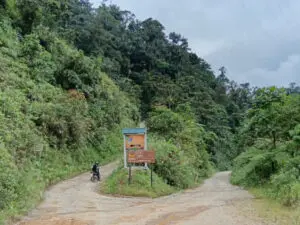Frequently Asked Questions (FAQ)
These FAQ will hopefully answer any questions that you might have about coming to visit us at the Mashpi Amagusa Reserve.
Why should I visit Mashpi Amagusa?
You should visit Mashpi Amagusa because you love the outdoors!
You might be looking for an affordable option to stay in the Mashpi area. Or you could be on a quest to see a specific bird. Maybe you want to introduce your children to the rich biodiversity of the Choco-Andino. As long as your reason to visit includes being outdoors, you are very welcome to be our guest.
Do I need a reservation?
Yes, we highly recommend making a reservation before you visit. We are a family-run operation and it is important for us to plan ahead.
Please do not arrive without first confirming that someone on the property is prepared to meet you.
For last minute reservations, you can always contact us via WhatsApp at +593-98-321-7713.
How do I get there?
If you are driving yourself, please be prepared for heavy fog anywhere along the road, especially early or late in the day. Also, expect winding roads along the E-28 and on the Via Pacto. After Pacto, the road turns to gravel. It is generally passable in all weather with mud in the rainy season and dust if it is dry. Finally, the last few kilometers of the road are narrow and unpaved. While we see very little traffic, please drive slowly on this narrower portion of your journey. If arriving during daylight hours, this route is actually a great opportunity to observe birds and other wildlife!
Here are links to our recommended driving directions:
- From Quito International Airport
- From Mindo
Be warned, Google Maps does have an alternative route that is non-existent in real life. We have placed a sign along the route to help you turn in the correct location. Please be attentive, especially in rain and fog so that you do not miss the turn towards our property.

Signs at the turn to Mashpi Amagusa and Mashpi Lodge
What is the weather like?
Here at Mashpi Amagusa, our climate is characterized by temperate, moist conditions.
With year round temperatures ranging from 15°C to 24°C (59°F to 75°F), our reserve sees frequent rainfall, creating a lush, green landscape. Mornings may start with a soft mist that gently lifts to reveal the vibrant hues of the forest, making every birdwatching expedition an enchanting experience. Alternatively, fog can roll it at any time of the day. In fact, on some days, we see fog, rain, and sun within hours of each other. Please come prepared for all weather.
What gear & clothing should I bring?
For an enjoyable visit to Mashpi Amagusa, it’s essential to come prepared for the cloud forest’s unique conditions. We recommend the following gear and clothing:
Waterproof Hiking Boots: The terrain can be uneven and slippery, so sturdy footwear with good grip is crucial.
Lightweight, Quick-Dry Clothing: Opt for layers that you can easily add or remove as the temperature changes throughout the day.
Long Pants and Long-Sleeved Shirts: These will protect you from insects and the sun.
Remember, the key is to stay comfortable, dry, and ready for adventure in the ever-changing conditions of the cloud forest.
Rain Gear: A high-quality, waterproof rain jacket or poncho is a must, given the frequent and sudden rain showers.
Binoculars: Enhance your birdwatching experience with a good pair of binoculars.
Headlamp: If you would like to enjoy a night-hike (overnight visitors only), bring a head lamp or strong flashlight with a targeted beam.
Insect Repellent: Protect yourself from insects, particularly during early morning or late afternoon excursions.
Sun Protection: Even in a cloud forest, UV rays can be strong. Bring sunscreen, sunglasses, and a wide-brimmed hat.
Reusable Water Bottle: Stay hydrated while minimizing your environmental footprint.
Camera with Zoom Lens: Capture the beauty of the birds and the lush landscape. A zoom lens will help you get close-up shots without disturbing the wildlife.
Light Backpack: Carry your essentials comfortably during your excursions.
Snacks: While our meals are hearty, some guests like to have snacks on hand, especially for children who need quick bursts of energy when hiking.
What birds can I see?
There are so many birds to see!
First, you might want to use this printable list from our website.
Second, you may want to know what you are most likely to see by season. Let’s help you out with a few lists from various months.
January, 2024, Sergio Basantes – 111 species in 9 hours, 3.08 miles.
February, 2024, Sergio Basantes – 122 species in 10 hours, 2.83 miles.
March, 2017, Kirk Huffstater – 85 species in 4 hours, 2.8 miles.
April, 2015 – Forrest Rowland – 75 species in 5 hours, 4.4 miles.
May, 2017, Segio Basantes – 106 species in 7 hours, 3 miles.
June, 2017, Nelson Apolo – 100 species in 6 hours, 2 kilometers.
July, 2016, Charley Hesse – 68 species in 4 hours, .62 miles.
August, 2017, Jose Illanes – 71 species in 6 hours, 4 miles.
September, 2016, Elsie Laura – 79 species in 5 hours, 2 kilometers.
October, 2017, William Vanderpoel – 73 species in 6 hours, 3 miles.
November, 2016, Heike Brieschke – 100 species in 7 hours, 2 kilometers.
December, 2015, Renato Espinosa – 67 species in 4 hours, 5 miles.
Which endemic birds can I see?
While we cannot guarantee any bird sightings, we do know that these 24 species can be found on the property. We have included their IUCN Rating with a link to the IUCN Red List.
Least Concern (LC), Near Threatened (NT), Vulnerable (V), Endangered (E)
- Moss-backed Tanager, Bangsia edwardsi (LC, decreasing)
- Indigo Flowerpiercer, Diglosa Indigotica (LC, decreasing)
- Choco Toucan, Ramphastos brevis (LC, decreasing)
- Choco Tyrannulet, Zimmerius albigularis (LC, stable)
- Black-chinned Mountain Tanager, Anisognathus notabilis (LC, decreasing)
- Glistening-Green Tanager, Chlorochrysa phoenicotis (LC, decreasing)
- Toucan Barbet, Semnornis ramphastinus (NT, decreasing)
- Banded Ground-Cuckoo, Neomorphus radiolosus (E, decreasing)
- Rufous-Throated Tanager, Tangara rufigula (LC, decreasing)
- Choco Vireo, Vireo masteri (NT, decreasing)
- Choco Brushfinch, Atlapetes crassus (LC, decreasing)
- Empress Brilliant, Heliodoxa imperatrix (LC, unknown)
- Velvet-purple Coronet, Boissonneaua jardini (LC, decreasing)
- Purple-bibbed Whitetip, Urosticte benjamini (LC, decreasing)
- Violet-tailed Sylph, Aglaiocercus coelestis (LC, stable)
- Gorgeted Sunangel, Heliangelus strophianus (LC, decreasing)
- Brown-Inca, Coeligena wilsoni (LC, decreasing)
- Rose-faced parrot, Pyrilia pulchra (LC, stable)
- Purple-quail Dove, Geotrygon purpurata (E, decreasing)
- Black Solitaire, Entomodestes coracinus (LC, decreasing)
- Orange-breasted Fruiteater, Pipreola jucunda (LC, decreasing)
- Cloud-forest pygmy Owl, Glaucidium nubicola (V, decreasing)
- Yellow-breasted Antpitta, Grallaria flavotincta (LC, stable)
- Baudo Guan, Penelope ortoni (E, decreasing)
Which frogs can I see?
While we have several frog species on the property, most people are interested in seeing these two species:
If you have a keen interest in herping, please let us know before your arrival! You may make a special request when using our reservation form.
Can I bring children to the reserve?
Absolutely, children are warmly welcomed at the reserve! Mashpi Amagusa is a splendid place for young explorers to learn about and experience the wonders of nature firsthand.
We believe that fostering a love for the environment from an early age is essential.
However, as this is a nature reserve with its unique set of environments and wildlife, we require that parents or guardians be with their children at all times to ensure their safety and to help maintain the tranquility of the natural surroundings. It’s a wonderful opportunity for families to bond and create lasting memories in the heart of nature.
Can I bring my dog to the reserve?
Unfortunately, visitors are not allowed to bring their dogs or any other pets to the reserve. We aim to preserve the natural habitat of the wildlife and ensure the safety and comfort of all our guests.
We appreciate your understanding and cooperation in helping us maintain the delicate ecosystem of Mashpi Amagusa.
What additional expenses might I expect?
When you visit Mashpi Amagusa, you might like to purchase something from our gift shop. We often have t-shirts, hats, water bottles, thermoses, artisan goods, and books like nature guides available for sale. We accept cash in US Dollars, the currency used throughout Ecuador, or payment through the Ecuadorian banking system.
If you have not prepaid for a meal and decide to add a meal on the same day, you will need to bring cash for that purchase.
Additionally, you may wish to provide a tip to your guide for excellent service or to offer a donation to the Mashpi Amagusa Reserve to put towards future conservation projects. For these items, we also suggest bringing cash.
What is your cancelation policy?
We request a 50% downpayment upon reservation. The remaining 50% is due 30 days prior to your arrival date.
- If cancellation is made 30 days or more before the tour departure date, we will offer a full refund, minus administration fees.
- If you choose to rebook rather than cancel, we will do so at no additional cost.
- If cancellation is made fewer than 30 days before departure date, we cannot gaurantee a full refund.
We strongly recommend that you purchase trip cancellation insurance for your protection.
What is your privacy policy?
We have a simple privacy policy that you can read here.
